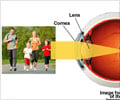General InfoAbout Hyperopia
Hyperopia is alsoknown as farsightedness, longsightedness or hypermetropia. It is a common visionproblem. Affected people have greater difficulty seeing near objects thandistant objects.
Hyperopia is a common visual problem where theaffected person is unable to see near objects clearly. Almost one fourth of the population isaffected by hyperopia. Hyperopia is typically caused due to genetic factors. It is often present from birth.
Hyperopia occurs if a person’s eyeball is tooshort or when the cornea is too flat when compared to the normal eye. The lightentering the eye focuses behind the retina, instead of directly on it, henceclose objects look blurred.
A person with hyperopia typically experienceseye strain and fatigue while trying to focus on near objects.
Young people with mild to moderate hyperopia areoften able to see clearly because their eyes can accommodate (adjust) toincrease the eye's focusing ability. However, in later years, the eyes graduallylose their ability to adjust the focusing power and blurred vision becomes more apparent.
Glasses or contact lenses can be used to correcthyperopia. Surgical techniques are also available for correctinglong-sightedness.













